|
|
|
Sort Order |
|
|
|
Items / Page
|
|
|
|
|
|
|
| Srl | Item |
| 1 |
ID:
146627
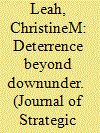

|
|
|
|
|
| Summary/Abstract |
From 1944 to 1973 Australia attempted to acquire atomic weaponry. This ambition was driven by the desire to contribute to defending British interests in Asia, fears of invasion by China, Indonesia, and Japan, great-power war, and the belief that nuclear weapons were merely bigger and better conventional weapons, that they would proliferate, and that US security assurances lacked credibility. Although the pursuit of the bomb was eventually abandoned, this was not the result of US assurances. Rather, geopolitical changes in Australia’s environment meant that a major attack on the continent was unlikely to occur outside the context of a confrontation between the US, China, and the Soviet Union. This article argues that Australia may soon have to rethink its policies towards US extended deterrence and instead focus on developing its own deterrent.
|
|
|
|
|
|
|
|
|
|
|
|
|
|
|
|
| 2 |
ID:
146626
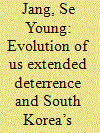

|
|
|
|
|
| Summary/Abstract |
Extended deterrence has been a main pillar of the security alliance between the United States and South Korea (Republic of Korea [ROK]) since the end of the Korean War. The changing dynamics of US extended deterrence in Korea, however, affected Seoul’s strategic choices within its bilateral alliance relationship with Washington. Examining the evolution of US extended deterrence in the Korean Peninsula until the Nixon administration, this article explains why South Korea began its nuclear weapons programme in a historical context of the US–ROK alliance relationship. This article argues that President Park Chung-hee’s increasing uncertainty about the US security commitment to South Korea in the 1960s led to his decision to develop nuclear weapons in the early 1970s despite the fact that US tactical nuclear weapons were still stationed in South Korea.
|
|
|
|
|
|
|
|
|
|
|
|
|
|
|
|
| 3 |
ID:
146629
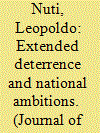

|
|
|
|
|
| Summary/Abstract |
Throughout the Cold War, Italy was one of the most steadfast NATO allies in hosting American nuclear weapons on its territory. Such a policy could easily be construed as an example of almost automatic confidence in the US nuclear umbrella, yet only on the surface did extended deterrence appease Italian anxieties about the uncertainties of the American nuclear guarantee. The Italian rationale for accepting a large array of US nuclear weapons did as a matter of fact involve a complex mix of reasons, ranging from trying to ensure that the Italian government would be consulted in the event of a major crisis, to willingness to enhance the country’s profile inside any Western multilateral fora. The paper will investigate this policy by looking at how the Italian government behaved at the height of the NATO nuclear sharing debate, between 1957 and 1962, arguably one of the historical moments in the Cold War when the concept of extended deterrence was most intensely discussed. Drawing up on hitherto classified archival sources as well as on some less-known public ones, the paper will show how Italian diplomats, military leaders and policymakers understood the dangers and political implications of US nuclear policies. It will, hopefully, demonstrate that Italy’s persistent search for a multilateral solution to the nuclearisation of NATO strategy shows that Italy never saw extended deterrence as a solution per se, but only as a temporary means to an end.
|
|
|
|
|
|
|
|
|
|
|
|
|
|
|
|
| 4 |
ID:
146625
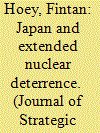

|
|
|
|
|
| Summary/Abstract |
To an observer, Japan’s approach to nuclear weapons can appear confused and contradictory. The only country to have been attacked with nuclear weapons is variously described as a pacifist and non-nuclear nation and as a proliferation threat. These widely varied and conflicting conclusions are understandable given that conflicting messages are sent by senior figures. However Japan’s stance is in fact a coherent, if not uncomplicated, response both to its security needs and to domestic public opinion. However, the security provided by US extended nuclear deterrence underlines and enables this approach. The key policies and decisions were taken in both Washington and Tokyo between China’s first nuclear test (1964) and Japan’s ratification of the Nuclear Non-Proliferation Treaty (1976). How the United States came to offer this additional security guarantee to Japan and how Japan came to rely upon it underscore this complex stance and are crucial to understanding a longstanding and ongoing security arrangement and source of stability and security in northeast Asia.
|
|
|
|
|
|
|
|
|
|
|
|
|
|
|
|
| 5 |
ID:
146628


|
|
|
|
|
| Summary/Abstract |
Recent nuclear-weapons-related consultation in NATO within the framework of the Defence and Deterrence Posture Review sheds light on historical experiences with nuclear consultation in NATO. In the early years of the Nuclear Planning Group (NPG), which became the main forum for multilateral nuclear consultation in the alliance, developing a nuclear weapons first use doctrine was of particular importance. This process led to the adoption of the Provisional Political Guidelines (PPGs) on the threat to initiate the use of nuclear weapons. With a focus on West Germany as the primary addressee of the NPG, it will be postulated that nuclear consultation functioned and may still be seen as an essential tool to manage the credibility of US extended nuclear deterrence in the framework of NATO.
|
|
|
|
|
|
|
|
|
|
|
|
|
|
|
|
| 6 |
ID:
146630
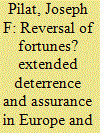

|
|
|
|
|
| Summary/Abstract |
The extended deterrence relationships between the United States and its allies in Europe and East Asia have been critical to regional and global security and stability, as well as to nonproliferation efforts, since the late 1950s. These relationships developed in different regional contexts, and reflect differing cultural, political and military realities in the US allies and their relations with the United States. Although extended deterrence and assurance relations have very different histories, and have to some extent been controversial through the years, there has been a rethinking of these relations in recent years. Many Europeans face a diminished threat situation as well as economic and political pressures on the maintenance of extended deterrence, and are looking at the East Asian relationships, which do not involve forward deployed forces as more attractive than NATO’s risk-and-burden-sharing concepts involving the US nuclear forces deployed in Europe. On the other hand, the East Asian allies are looking favorably at NATO nuclear consultations, and in the case of South Korea, renewed US nuclear deployments (which were ended in 1991), to meet increased security concerns posed by a nuclear North Korea and more assertive China. This paper explores the history of current relationships and the changes that have led the allies to view those of others as more suitable for meeting their current needs.
|
|
|
|
|
|
|
|
|
|
|
|
|
|
|
|
|
|
|
|
|